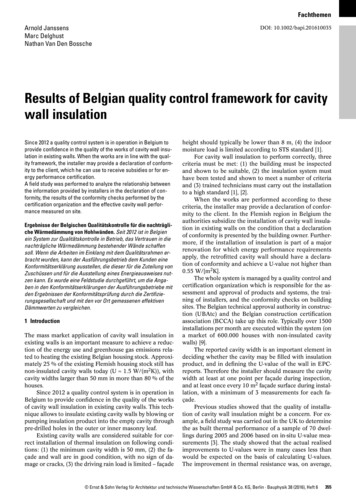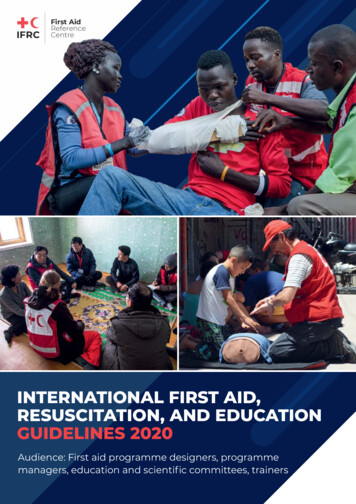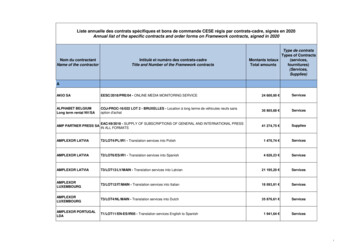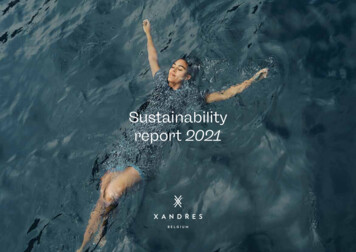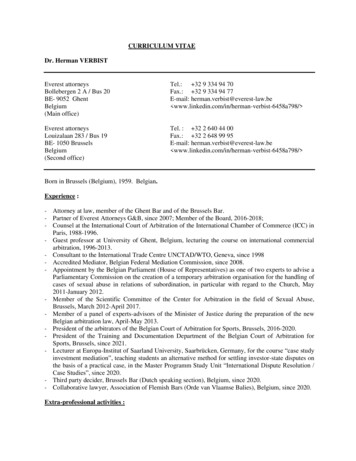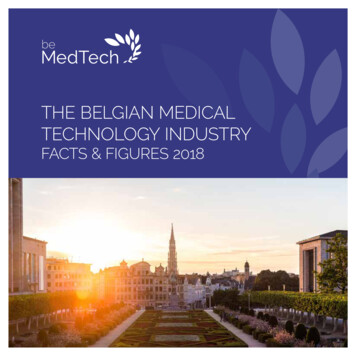
Transcription
THE BELGIAN MEDICALTECHNOLOGY INDUSTRYFACTS & FIGURES 2018
The Belgian Medical Technology IndustryFacts & Figures 2018Table of contents12A word from our presidentpage 37Past & future trendspage 28a.b.c.d.e.2What is Medical Technology?page 63About beMedTechpage 884The Belgian Pact on Medical Technologiespage 1295The medical technology market in Belgiumpage 19106The Belgian workforcepage 26RevenueWorkforceClinical researchClinical investigationsStructural (dis)investmentsImpact assessment of Belgian & European trendson profitabilitypage 39Patient accesspage 46Top 10 priorities for the new Belgian legislaturepage 49
1A WORD FROMOUR PRESIDENT3
A word from our presidentThe Belgian healthcare system isfacing major challenges. There isthe aging population and a growingnumber of chronically ill people,both significantly increasing theneed for care. There are also everhigher quality requirements, agrowing shortage of healthcareprofessionals and increasinglycritical and vocal healthcareconsumers. Thanks to advancesin medical technology anddigitization efficient solutions aremade available to address thesechallenges. They cover prevention,diagnostics and treatment.However, the care budget islimited, so choices need to bemade. A transversal value-basedapproach is needed.4Our current healthcare system is under heavy pressure andwill not remain sustainable in the long run. A paradigm shifttowards value-driven care and a transversal approach isnecessary to ensure the financial sustainability and qualityof our care system. We need to change the silo-thinking ofvarious healthcare actors, as this supports the budgetarysilos. In addition, there are a number of dysfunctions in thecurrent performance-based healthcare financing model thatencourage volume and overconsumption. Care providersand institutions are all too often rewarded on the basis of thenumber of interventions they perform, not on the quality orefficacy of the care they offer.These silos and the fragmented financing stand in the wayof budget-efficient healthcare. From now on we need tosucceed in doing more with the same budget and at thesame level of quality. It is necessary to continue evolvingtowards value-driven care, where not only the costs of theproducts are looked at, but where all of the expenses andsavings they entail along the entire care trajectory are putinto the equation. In such a transversal approach, the goalis to search for efficiency gains in all care structures andarrive at a point where budgets will always be allocated tothose solutions that create the greatest value throughoutthe entire care process.The effective application of value-driven care in Belgium isand remains a challenge. The fragmentation of competenciescomplicates the process of raising awareness about ouradded value, because the effects of a technology usuallydo not stop where institutional competence ceases.
The good news is that the government is increasinglylooking for efficiency gains and, amongst other things, theMedical Devices Pact confirms the realisation that medicaltechnologies are part of the solution (an investment that paysoff) and not part of the problem (a pure cost).Maggie De Block’s action plan for hospital financing reformis also an important step in the right direction. One of thespearheads of this action plan is the establishment of hospitalnetworks, allowing hospitals to jointly invest in the latesttechnology for diagnostics and therapy. Another principlethat is being carefully introduced is the ‘pay 4 quality’principle, where the hospital is rewarded for good quality ofcare and not on the basis of the number of interventions.Yet another important pillar for us is the creation of a clearframework for home hospitalisation, a domain in whichseveral of our members are active. Here too work is beingdone that offers further opportunities for cost efficiency. Thebasic principle of a value-driven healthcare system shouldbe that care is provided at the most efficient place.In the same spirit, a study is being conducted at the NIHDIwhere treatments are approached transversally. Thisconcerns the replacement of pacemakers in a day hospitaland the use of mechanical thrombectomy. The results of thisstudy could help to bring about a serious change in thinking.If we continue to think from a silo perspective, withoutpaying attention to efficiency gains such as shorter hospitalstays and a faster return to work, I fear that fewer and fewerinnovative treatments will become available in Belgium. Thisis an aspect to which I wish to draw the attention of the healthauthorities.Another important aspect is the increased awareness of thevalue of in vitro diagnostics (IVD), including in the domainof personalised medicine. In this context, Maggie De Blockrecently launched a new initiative aimed at optimising theuse of modern DNA analysis techniques (next-generationsequencing) in cancer prevention.landscape. Recently, the platform www.mhealthbelgium.bewas set up for the mobile health apps, which will soon containdetailed information about validated health apps in our countryand their added value for patients and healthcare providers.Minister De Block also recently laid down the cornerstones fora regulatory framework for teleconsultations, in which patientswill be able to rely on the same safety and quality guaranteesin consultations from a distance as in those conducted face-toface. We also welcome the recent launch of the “data for betterhealth” initiative, which looks at how the enormous amount ofclinical data, collected in part via medical technologies, can beopened up in an aggregated way to improve the effectivenessof diagnostics and treatment.The digitization of healthcare needs to continue becausethere are many efficiency gains to be made.The ever-accelerating developments in the field of artificialintelligence open up exciting prospects in the areas ofdiagnostics and care. The speed of this evolution does notallow us to have a clear picture yet of what healthcare will looklike in the coming years. What is certain is that the changeswill be profound and rapid. Hopefully, our healthcare systemcan benefit from these developments, while of coursepeople, and especially the patients, remain the central pointof focus.beMedTech is keenly aware of the need for value-based careand offers a range of solutions that can help to achieve this.We want to continue working with the government and otheractors in the sector to ensure both the quality of patient careand the sustainability of the healthcare system as a whole.Annick De KeyzerPresident beMedTechThere is also a lot going on in e-health. The Mobile HealthBelgium initiative and the eHealth Action Plan show thatdigital technologies have their place in the Belgian healthcare5
26WHAT IS MEDICALTECHNOLOGY?
What is Medical Technology?Medical technology are all products and equipment that fall within thescope of the European Directives for Medical Devices (93/42/EEC),Active Implantable Medical Devices (90/385/EEC) and In-Vitro Diagnostics(98/79/EEC). These directives are replaced by new European Regulations.The scope of medical technology is very broad. It covers consumables(bandages, syringes, hearing aids, wheelchairs, .), implants (hips and knees,stents, pacemakers, .), medical equipment (imaging machinery, dialysisequipment, ) and in-vitro diagnostics.Over the next few years, the European medicaltechnology sector will transition from beingregulated under the current medical devicesdirectives to two new regulations. From 26 May2020, the new Regulation 2017/745/EU will fullyapply to medical devices. Until this date, medicaldevice manufacturers can choose to comply witheither the Directives or the Regulation. From 26May 2022, the new Regulation 2017/746/EU willfully apply to in-vitro diagnostics. Until this date,IVD manufacturers can choose to comply witheither the Directive or the Regulation1.The healthcare landscape is in full transformation.The sector of medical technologies can play animportant role in the whole chain of care, fromprevention, diagnosing, monitoring, evaluating totreating patients. There are more than 500,000medical technologies currently available inBelgium.1 The European Medical Technology Industry – in figures / 2018 by MedTech Europe7
38ABOUT BEMEDTECH
About beMedTechbeMedTech is the Belgian federation of the medical technologyindustry and has more than 200 affiliated companies. Its members aremanufacturers and/or distributors and are divided into five productsegments: in-vitro diagnostics (IVD), consumables, implants, medicalinvestment goods (MES) and Extra Muros solutions, including DigitalHealth. Together they represent over 500,000 technologies for anannual turnover of 2.4 billion not including export and they accountfor approximately 16.820 FTEs in Belgium*. beMedTech estimates thatthe total medical device industry has a turnover of about 3.5 billionand employs about 20,000 people.Our missionbeMedTech unites the Belgian manufacturers and distributors of medical devices to emphasizetheir positive role for the healthcare sector. The beMedTech members invest in innovative medicaltechnologies and in the training and education of health professionals. Together with its members,the federation contributes in a responsible manner, both to the quality of patient care and to thesustainability of the healthcare system.* Data on file at beMedTech, survey among its members, 2018. Figures do not include the non-responders to the survey and the (made-to-measure) devicesthat are custom-made (by dental labs, orthotists, prosthetists, ) or sold directly to end-users (such as hearing aids, eyewear, .).9
Timeline beMedTech19581987199020002001“U.N.A.M.E.C. - Uniondes Négociants enAppareils et Accessoiresmédicaux, chirurgicauxet pharmaceutiques Union professionnelle” isfounded by 4 distributorsin medical materialCreation of“v.z.w UNAMECBeroepsvereniging vanfabrikanten, invoerdersen verdelers vanmedisch materiaal enuitrusting” - “a.s.b.l.UNAMEC- Associationprofessionnelle defabricants, importateurs etdistributeurs de matériélet équipement médicaux”UNAMEC represents100 membersUNAMEC becomes:“Beroepsvereniging vanfabrikanten, invoerdersen verdelers vanmedische hulpmiddelen”“AssociationProfessionnelle desfabricants, importateurset distributeurs dedispositifs médicaux”PresidentPhilippe Biart enlargesthe permanentsecretariat withexperts active withinthe sector1993European DirectiveMedical Devices(93/42/EEC)1998The bylaws ofU.N.A.M.E.C. arepublished in the BelgianOfficial JournalPresident André Fockedeyestablishes a membershipfee system to raise thefinancial means to havea permanent secretariatand organizes themembers in sections20092010201120122013UNAMEC changes itsbrandingUNAMEC createsexecutive committees(ExeCo’s) for thedifferent productgroups it represents(Consumables, MedicalEquipment & Systems,Implants, Diagnostics)The “AgreementCommission for Implants”becomes the CRIDMI/CTIIMHLaurette Onkelinx,Minister of Health,announces the“Plan Medical Devices”,aiming to improve thetraceability, assessmentand supervision of MDsUNAMEC organizes itsfirst training “Externalstaff in the operatingtheater“ together withZorgnet1959UNAMEC publishes anelaborate analysis of themedical devices sector inBelgiumThe database for notifiedimplants is introduced10European Directive ActiveImplantable MedicalDevices (90/385/EEC)European DirectiveIn-Vitro Diagnostics(98/79/EEC)UNAMEC represents188 membersA new section “MedischeVoeding” – “AlimentationMédicale” is createdUNAMEC changesfrom a professionalassociation to afederation: “Fédérationbelge de l‘industrie desTechnologies médicalesa.s.b.l.” / “BelgischeFederatie van de industrievan de medischetechnologieën v.z.w.”UFPI becomes theUNAMEC section“Hoorapparaten Appareils auditifs”
20032004200620072008In order to enhance theimage of the federation,the offices move fromVilvoorde to Wemmeland the federation startsto focus more on itscommunication with theoutside worldUNAMEC becomesa member of theTechnical Board for theWheelchairs (TBW) ofthe National Institutefor Health and DisabilityInsurance (NIHDI)The Federal Agency forMedicines and HealthProducts (FAMHP) iscreated by law in July2006, with UNAMECrepresenting the medicaldevice industry in theTransparency CommitteeUNAMEC works closelytogether with NIHDIfor the introductionof new regulation onreimbursement ofimplantsUnder the presidencyof Paul Soenen, the IVDcompanies join UNAMEC(transferring frompharma.be)UNAMEC publishes itsfirst Annual ReportMdeon, the ethical healthplatform, is created –UNAMEC, with directorand driving force RichardVan den Broeck, is one ofthe founding members20152016Launch of thedisclosure platformbetransparent.beMaggie De Block,Minister of Health,announces the “Pact onMedical Technologies”UNAMEC becomesbeMedTech, thefederation of the medicaltechnologies industryUNAMEC is selected asthe sectoral operatorfor The Belgian Bureaufor Standardisation(NBN), responsible fordeveloping, publishingand selling standards inBelgium20172018Publication of newEuropean regulation formedical devices and invitro diagnostic medicaldevicesTogether with Agoria and the Belgian Federation ofHospital Directors, HealthTech.Belgium is launched,an initiative to make Belgium the preferred region forresearching and testing of Health Tech.Voluntary disclosureof interactionsbetween medicaldevice industry andhealthcare professionalsand institutions onbetransparent.beIn October 2018, beMedTech represents 209 membersbeMedTech organizes a symposium for its 60thanniversary & publishes its Facts & Figures 2018 on theBelgian Medical Technology IndustryUnder the presidency of Annick De Keyzer,beMedTech publishes its memorandum 2019-202411
412THE BELGIAN PACT ONMEDICAL TECHNOLOGIES
BackgroundIn October 2016 the “Pact on Medical Technologies” was signed between Maggie De Block,Minister of Public Health, and beMedTech. The pact was a result of intense and constructivediscussions between the federation and the 3 main administrations (Federal Public Service Health,the reimbursement agency National Institute for Health and Disability Insurance (NIHDI), and theFederal Agency of Medicinal and Health Products (FAMHP). It was the first time such a dialogue hadtaken place, and it resulted in an agreement to work around 32 topics. The objective of the Ministerwas clear: through agreements, laws and rules provide the highest possible guarantee to safeand accessible medical devices. Some of the 32 topics are transversal, across the different typesof medical devices. The implementation of the new Medical Device and IVD Regulations, a newframework on care outside of hospitals, a transversal evaluation of medical devices inside NIHDI areexamples of such transversal topics.Other topics relate to the specific nature of some groups of medical devices, like implants, IVD,consumables or medical equipment.Summary of main achievementsTransversal Topic #2:Transversal Topic #3:AutocontrolServices & Technologies HomeAssistance (STHA)The objective was to make sure that all medical device actors(manufacturers, distributors, importers, ) are known by theFAMHP and that these actors go through a self-assessment,which, in turn, optimizes the inspection efforts. The legal baseis set in the Royal Decree of November 15, 2017.With the contribution from the industry through the meddevtax, the FAMHP set up a web-based platform, resultingin a registration of 2,000 (and counting) additional actors,formerly unknown to the FAMHP.The objective was to provide a legal framework forcompanies that currently support care outside hospitals byinstalling, maintaining and repairing medical systems, byproviding the consumables that go with it, and by educatingthe patient on the proper usage. The framework entailsthe development of a General Guide and Therapy-specificguides. Registered STHA companies will have to indicate inthe Autocontrol system whether they follow these guides.The law of December 18, 2016 adapted the law regardingmedical devices of December 13, 2015, to allow for theGuides. Efforts of FAMHP and beMedTech resulted in thedevelopment General Guide, expected to be published byend 2018. The first therapy-specific guides, as well as thefinancing models are expected in 2019.13
Transversal Topic #11:Implants, Topic #17:Deontology and transparencyTraceability of implantsThrough Mdeon, founded in 2006, the industry tookvarious initiatives to self-regulate the interactions betweenindustry and healthcare providers and professionals. In 2017,the members of pharma.be and beMedTech voluntarilydisclosed the interactions, on www.betransparent.be.As of May 2018, after the Royal Decree of the Sunshine Actof 14th of June 2017, all actors are legally obliged to yearlydisclose their interactions with healthcare professionals,thus creating a transparent and level playing field.At the initiative with NIHDI with the efforts of the industry,all available implants are searchable in one single database.The ownership of this database moves from NIHDI toFAMHP by end 2018. As for a Central Traceability Registry,providing insights into which patient has received whichimplant, this is supported today by a limited amount ofhospitals. However, this doesn’t mean there is no traceability.Within their decentralised databases, all hospitals are ableto trace all implants, all the way to the patients.Transversal Topic #12:Implants, Topic #20:Administrative SimplificationCommission reimbursement of implantsand invasive medical devicesThe market access, vigilance and regulatory servicesregarding IVD moved from Sciensano (formerly WIV-ISP) tothe FAMHP. It’s a small step in the Redesign, in which the 3large administrations (Federal Public Service Health, NIHDIand FAMHP) will move into one building, with the objectiveto create synergies. However, resources to support IVDinside the FAMHP are still limited, despite the contributionfrom the IVD industry through the meddev tax.The analysis regarding the synergies with the FederalAgency for Nuclear Control (FANC) has not taken place yet.This commission needed some improvements regarding theirprocedures. After an internal evaluation some adaptations areplanned, moving in the right direction. These are foreseen inthe law but need to be made concrete by subsequent RoyalDecrees. The following adaptations have been made: TheCommission can involve experts, to enhance the scientificdiscussion. Scientific associations can request reimbursementof various technologies. The possibilities to request a “LimitedClinical Usage” will be expanded. There will be the possibilityfor alternative, negotiated, financing models that include, forexample, risk sharing.Transversal Topic #15:Financing of the PactThe increased need for evaluators of medical technologiesinside the NIHDI is supported by the medical deviceindustry by a structural and yearly contribution of 500,000EUR. It is financed with the meddev tax, and flows throughvia the FAMHP.Transversal Topic #16:Monitoring of the PactA Steering Committee, with members of the cabinet,FAMHP, NIHDI and beMedTech meets every 10 weeks, toevaluate the progress on the various components of thePact.14Consumables, Topic #28:Optimizing the Technical Council forDiagnostical and Care Products (TRDVM-CTMDS)The objective was to simplify and harmonize the proceduresof this council, to enable patients faster access to newtechnologies/provisions. It has changed its name tothe “Commission for reimbursement of pharmaceuticalproducts and procurements”. The Royal Decree should bepublished at the end of 2019, and be in effect as of 2020.The industry will be present, without voting rights, in thecommission itself, as well as in the working groups thatprepare the dossiers for the commission. The turnaroundtime of a dossier is set to a maximum of 370 days.
Medical Equipment, Topic #29:Cadaster of heavy equipment for medicalimagingAs of 2018, all hospitals that have heavy medical imagingequipment declare their assets, so that government canmanage and control the supply of medical imaging. It ispart of the solution to decrease the radiation exposure. Theobjective is to reduce the number of CT-scans by offeringMRI examinations instead. The Cadaster is now fully upand running, at first by the input of beMedTech membercompanies, now by the hospitals themselves. It is nowmanaged by a collaboration between FPS Health, NIHDI,FANC and the Belgian Medtech industry.Overview of topics that arework-in-progressTransversal Topic #1:New European RegulationsFrequent interactions with the FAMHP are taking place, buthave not yet resulted in any local legislation or actions, alsobecause the implementing acts have not been clarified at theEuropean level. The current ongoing discussions betweenFAMHP, beMedTech and other stakeholders related mainlyto the frameworks around: the distribution channels ofmedical devices, the re-use of single-use devices, and thelab-developed in vitro diagnostics (“In-House tests”).Medical Equipment, Topic #30:Maintenance of medical equipmentIt is critical for the quality of care that medical equipmentis used in an optimal way. Therefore a legal frameworkaround the education of operators and the maintenanceof the equipment is desirable. Initial consultations with theumbrella organizations of hospitals and biotechnicians havetaken place during 2018.Medical Equipment, Topic #31:Mobile ApplicationsThis action item resulted out of the Action Plan e-health,in which dedicated attention was put to mobile health(m-health). The 24 approved pilot projects ran until 2017and were evaluated early 2018. It resulted in a frameworkin which m-health applications will be evaluated andpublished according to 3 levels: CE-Marking as medicaldevice and GDPR compliance, interoperability with thegovernmental e-health services and financing. beMedTechand Agoria, in partnership with FAMHP, NIHDI and thee-health services launched the website mhealthbelgium.be.It soon will provide the necessary qualitative information topatients and healthcare providers regarding the availablemobile applications.Transversal Topic #5:VigilanceAn information campaign around materiovigilance andmedical devices is being developed by the FAMHP. Regardingthe Central Tracing Registry of Implants, it is in place, but notused across the board, as the actual IT-solution does notavoid double work for hospitals. However, decentralisedinformation in every hospital allows to trace exactly whereeach implant has been implanted, especially for reimbursedimplants. The solution for full traceability of all implants liesin the implementation of the UDI (Unique Device Identifier),expected in March 2020.Transversal Topic #6:National Cadaster of medical devicesThe authentic source of all available medical devices (MDREudamed) is a European initiative and is supposed to be readyin March 2020. This will serve as the reference for Belgium.The industry is fully preparing itself by implementing the UDI(Unique Device Identifier). As for the cadastre of the availableimplants in Belgium, this has been available for a while now.The management of this cadastre will move from NIHDI tothe FAMHP by end 2018.15
Transversal Topic #8:Implants Topic #18:Working Group Budget and Evaluation ofMedical DevicesThe optimal use of implantsThe industry has kept its commitment to save 41 m. EURinside the budget of the implants, as agreed in the pact.Unfortunately we cannot report that the permanent WorkingGroup inside the NIHDI has been set up. It means that thebudgetary impact of the interventions of the health insurancecannot be analysed for all medical devices. It also means wecannot measure the transversal efficiencies that innovativemedical devices can bring. As a result, the opportunities ofmedical devices are not fully captured. For more details, seethe Memorandum 2019-2024, and the recommendations 1,4 and 5.Transversal Topic #9:3D-printingAs planned, the KCE-report (297A) regarding 3D Printingwas published early 2018. beMedTech took part in thedialogue between authorities, KCE and industry. Finalconclusions regarding the framework around regulatory andreimbursement have not yet been reached.Transversal Topic #10:Diabetes conventionIn the Royal Decree of March 1st 2018 that addressesthe diabetic convention there are some issues with theverbiage of the clauses on the educational information thatpatients receive from the industry. beMedTech and someof its members started a procedure at the Council of Stateto resolve these issues. In order to avoid such problemsand to optimize the execution of the convention as wellas accelerate the access of patients to new technologiesbeMedTech has requested to get a seat on the board ofagreement (akkoordraad/conseil d’accord) of the diabeticconvention inside the NIHDI.16The goal is to optimize specific and complex treatments byconcentrating them in specialized centers. The objectivecriteria to determine these centers of excellence are not yetset. As a result, some innovative technologies do not findtheir way to the patients, not even in the framework of theLimited Clinical Application.Implants, Topic #19:Big DataWith the increased demand for data regarding the usage ofmedical devices, and the need for data to support the healtheconomic argumentation for new technologies, it was theobjective to investigate how data could be made availableto the industry. We cannot report much progress. Still today,there is no procedure for the medical device industry toaccess any of the available data at the Inter Mutualistic Agency(IMA). It is however mentioned in IMA’s plan for 2019, underthe umbrella of dataforbetterhealth.be, which is supportedby Sciensano. The policy note on dataforbetterhealth.be willbe presented by the Minister of Health in February 2019.IVD, Topic #22:In-House testsAt the initiative of the FAMHP, the first initial meeting aroundthe framework of in-house tests took place in September2018. The first step is to analyze and agree on what is meantby the rules set out by the IVDR.IVD, Topic #23:Point-of-care-testingPoint-of-care tests are the decentralized tests, outside oflabs, close to the patient, done by first-line physicians or bypatients themselves. The efforts around a clear regulatoryframework, to ensure the correct execution of the tests, haveresulted in a final document that was drafted by Sciensano, inconsultation with the industry. It is currently in the pipeline tobe transposed into legislation, the timeline is unknown.
IVD, Topic #24:Specific reimbursement procedure for IVDtestsOne of the cornerstones of the pact was to define a fasterand more transparent procedure for IVD. Today such aprocedure still does not exist. The activities within theworking group Clinical Biology remain opaque, without anytransparency regarding agendas, timelines and decisions.This is surprising, given the increasing role that IVD playin prevention, diagnosis and treatment. The IVD industryrequests an urgent follow up.Overview of topics that have notyet startedTransversal Topic #4:Training and Education of healthcareprofessionals on medical devicesThis project, where cooperation is needed betweenbeMedTech, FAMHP and universities, has not yet started.Transversal Topic #7:IVD, Topic #25:Next Generation Sequencing (NGS)The pilot projects to test targeted NGS in real life are ongoing,and will run until 2021. The objective is to introduce targetedNGS inside the molecular diagnostics in oncology after thepilot projects.Quality AnalysisInside the MDR and IVDR a framework for European anduniform quality inspection rules is to be set up. In Belgiumsome national reference labs are already analysing theperformance and safety of medical devices. This projectrefers to the analysis of the feasibility of the access of Belgianquality assessment labs to the EU-network. It has not yetstarted.Consumables, Topic #27:Re-use and sterilization of products in-houseMedical devices that are CE-marked for single use aresometimes reprocessed by hospitals. The upcoming Europeanregulation gives the autonomy to the FAMHP to define a set ofrules to which the hospitals need to adhere to in Belgium.A working group with all relevant stakeholders has beenset up by the FAHMP. A survey among hospitals on theircurrent practices has been held, and the results have beenpresented in September 2018. The final rules and proceduresfor hospitals around quality, safety, hygiene and patientconsent have not yet been defined.Transversal Topic #13:Classification procedureThe project around the improvement of the classificationprocedure of borderline products by the “Mixed Commission”has not yet started. It is also linked with the European efforts,where the goal is to have a uniform European classificationprocedure.Transversal Topic #14:Medical Devices and Animal HealthThe reflection around the framework of the usage of medicaldevices for animal health has not yet started.17
Implants Topic #21:Procedure for the price stipulationUnfortunately no progress to report on the simplification ofthe price procedure for implants. Costly double work stilltakes place at the Federal Public Service Economy andNIHDI, leading to a delay in bringing the latest technologyto patients. Furthermore, the harmonization of the VAT tarifffor all implants and invasive medical devices has not yetbeen addressed. We continue to have a situation where,without a clear rationale, some implants or invasive medicaldevices have a tariff of 6% VAT, others have a VAT of 21%.In comparison, all medicines have a VAT tariff of 6%.IVD, Topic #26:Prevention protocolsThis project around the coordination between federal andregional authorities of IVD for prevention and screening hasnot yet started.Medical Equipment, Topic #32:Follow-up of technological evolutionsThe research to investigate whether or not a monitoringgroup can be set up inside the House of the Future to followup the technologica
1 The European Medical Technology Industry - in figures / 2018 by MedTech Europe Over the next few years, the European medical technology sector will transition from being regulated under the current medical devices directives to two new regulations. From 26 May 2020, the new Regulation 2017/745/EU will fully apply to medical devices.


